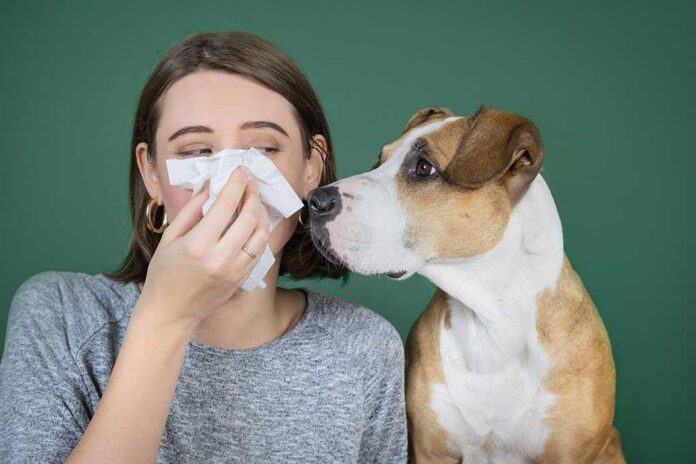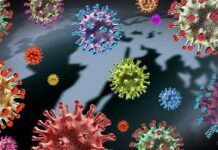
A 26-year-old pregnant woman developed a massive parasitic cyst in her abdomen from a tapeworm likely contracted from her dog, highlighting why pet owners need to understand and prevent zoonotic disease transmission.
At a Glance
- Over 60% of known infectious diseases in humans can spread from animals, with three-quarters of emerging infectious diseases coming from animal sources
- High-risk groups for serious illness from zoonotic diseases include children under 5, adults over 65, immunocompromised individuals, and pregnant women
- The woman’s condition involved a hydatid cyst caused by a tapeworm found in infected dog feces or saliva
- Regular veterinary care, including vaccinations and parasite control, is essential for both pet and human family health
- Preventive measures include maintaining good hygiene, proper food handling, and regular deworming of dogs
Understanding Zoonotic Diseases
Zoonotic diseases, or zoonoses, represent a significant public health concern for pet owners. These conditions transmit between animals and humans through various pathways, including direct contact, indirect contact, vector-borne transmission, foodborne routes, and waterborne spread. The recent case of a young pregnant woman developing a massive parasitic cyst from a dog-transmitted tapeworm serves as a stark reminder of how these diseases can seriously impact human health when preventive measures are overlooked.
“Zoonotic diseases (also known as zoonoses) are caused by germs that spread between animals and people.” CDC
According to health experts, the scope of zoonotic diseases is extensive. The CDC reports that scientists estimate more than 60% of known infectious diseases in people can transmit from animals. Even more concerning, approximately 75% of new or emerging infectious diseases in humans originate in animals. This makes understanding and preventing these diseases crucial for anyone sharing their home with pets.
Common Zoonotic Diseases from Dogs
Dogs can transmit several zoonotic diseases to their human companions. Among the most common are parasitic infections like roundworms, hookworms, and tapeworms, which can spread through contact with contaminated feces. Bacterial infections such as salmonellosis and leptospirosis can transmit through contaminated food, water, or direct contact. Fungal infections like ringworm spread through direct contact with infected animals. Vector-borne diseases, including Lyme disease, are transmitted through intermediaries like ticks and fleas that move between pets and people.
“Scientists estimate that more than 6 out of every 10 known infectious diseases in people can be spread from animals, and 3 out of every 4 new or emerging infectious diseases in people come from animals.” CDC
The hydatid cyst case highlighted in recent news demonstrates how these transmissions can occur. The woman developed a massive cyst caused by the Echinococcus tapeworm, which typically cycles between dogs and livestock but can infect humans when they accidentally ingest microscopic eggs from dog feces or contaminated surfaces. This particular case underscores the importance of proper hygiene and regular veterinary care to prevent such serious health consequences.
Prevention Strategies for Pet Owners
Effective prevention of zoonotic diseases requires a multi-faceted approach that combines good hygiene practices, regular veterinary care, and awareness of transmission pathways. Handwashing remains one of the simplest yet most effective preventive measures. Washing hands thoroughly with soap and water after handling pets, cleaning up after them, or before eating significantly reduces transmission risks. When soap and water aren’t available, alcohol-based hand sanitizers provide an alternative, though they’re less effective against certain parasites.
Regular veterinary checkups form another critical component of prevention. These visits should include comprehensive parasite control programs tailored to your dog’s lifestyle and regional risks. Most veterinarians recommend year-round parasite prevention for dogs, which protects both the animal and their human family members. Vaccinations for diseases like rabies also prevent potentially fatal zoonotic transmission. Additionally, prompt attention to any signs of illness in your pet can prevent the progression of conditions that might pose risks to humans.
“The level of understanding from the surgeon I spoke with was greatly appreciated. Especially during a tough time.” Jerome Hunley-Ellis
Special Considerations for Vulnerable Populations
While everyone should practice good hygiene and preventive measures with their pets, certain groups face heightened risks from zoonotic diseases. Children under five years old, adults over 65, pregnant women, and people with weakened immune systems due to conditions like HIV/AIDS, cancer, or organ transplants should take extra precautions. These individuals may experience more severe symptoms if infected and might contract infections more easily than the general population.
For these vulnerable groups, additional preventive measures become important. Having another family member clean up pet waste, ensuring children don’t put their hands in their mouths after touching pets without washing, and maintaining extra vigilance about regular veterinary care can help minimize risks. However, it’s worth noting that the health benefits of pet ownership—including decreased blood pressure, reduced loneliness, increased opportunities for exercise, and improved mental health—often outweigh the risks when proper precautions are taken.
By understanding zoonotic disease risks and implementing appropriate preventive measures, pet owners can enjoy the countless benefits of the human-animal bond while keeping both their pets and families healthy. Regular veterinary care, good hygiene practices, and awareness of transmission pathways form the foundation of responsible pet ownership that protects everyone in the household.
























